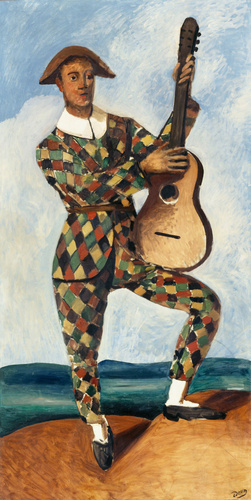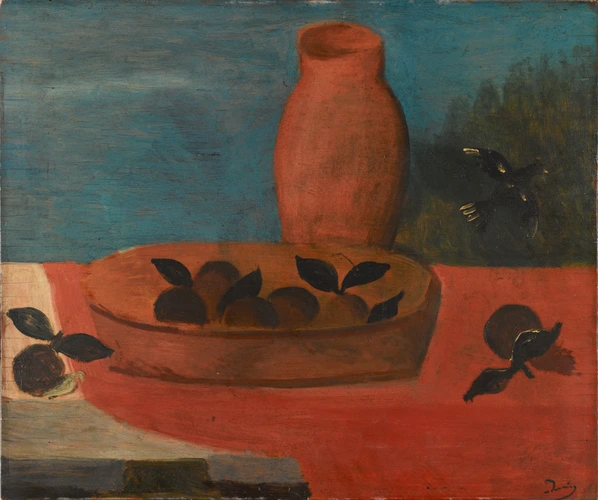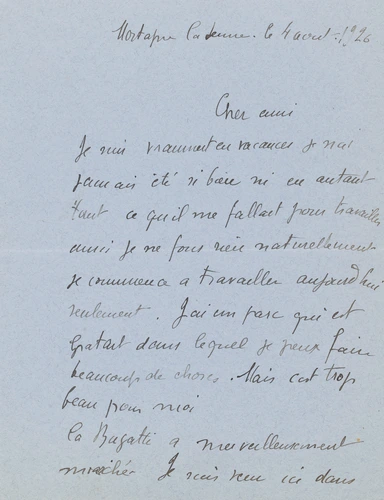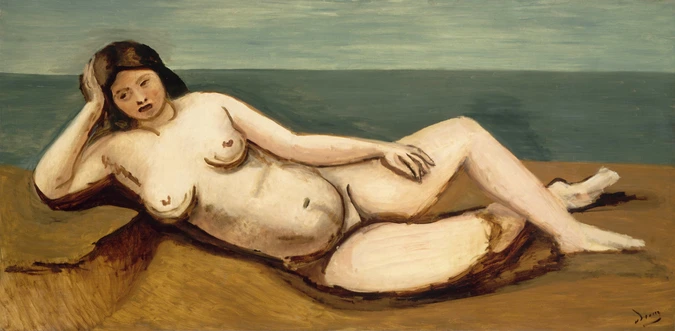Arlequin et Pierrot
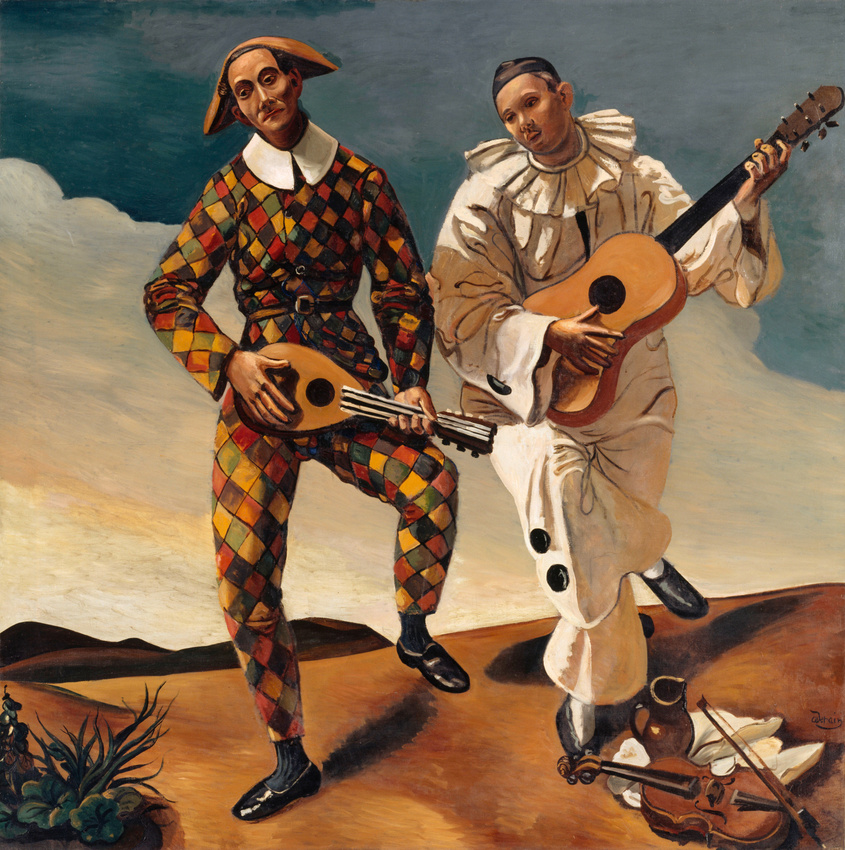
This famous painting at the Musée de l'Orangerie was an order André Derain received from Paul Guillaume. Derain chose to depict two characters from the Italian theatre known as the Commedia dell’Arte: Harlequin in his colourful chequered costume and bicorn hat, and Pierrot in his white frock with ruff, head covered by a black calotte. Amongst the painters, Paul Cézanne (1839-1906), Auguste Renoir (1841-1919) and Pablo Picasso (1881-1973) had already taken an interest in this theme of saltimbanques that had been popular since the 16th century.
Nonetheless, Derain created an original work: Harlequin and Pierrot, with one knee raised and both playing the guitar, appear against a neutral background in a never-ending dance like marionettes or puppets. Their gazes do not meet and they have serious expressions on their faces. Therefore the painting is suffused with a certain melancholy quality. Derain prepared for this work by making several preliminary drawings. He also paid close attention to the small still life in the bottom right of the painting that anchors the composition. The figure of Pierrot was finally recognised as a portrait of Paul Guillaume.
This painting appeared several times during the lifetime of its sponsor. It can be seen in a photograph of his flat on Avenue de Messine. Derain alluded to this painting in the background of a portrait of Domenica Guillaume that he painted between 1928-1929 and that is conserved at the Musée de l'Orangerie.
Provenance: Paul Guillaume; Domenica Walter
- à partir de 1925, dans la collection Paul Guillaume, Paris
- jusqu'en 1959, dans la collection de Mme Jean Walter, Paris
- 1959, acquis de Mme Jean Walter avec le concours de la Société des Amis du Louvre (arrêté d'approbation de la vente du 21/02/1959)
- musée du Louvre, Paris
- musée de l'Orangerie, Paris
- Collection particulière de M. Paul Guillaume - galerie Bernheim-Jeune - France, Paris, 1929-1905
- Derain - musée national d'art moderne - France, Paris, 1954-1955
- Collection Jean Walter-Paul Guillaume - musée de l'Orangerie - France, Paris, 1966
- Derain - Villa Médicis - Italie, Rome, 1976-1977
- Les Réalismes (1919-1939) [titre frs] ; Realismus : Zwischen Revolution und Reaktion (1919-1939) {titre all) - Centre Pompidou - Chine, Shanghaï, 1980-1981
- Les Réalismes (1919-1939) [titre frs] ; Realismus : Zwischen Revolution und Reaktion (1919-1939) {titre all) - Staatliche Kunsthalle - Allemagne, Baden-Baden, 1981
- Derain - Scottish National Gallery of Modern Art - Royaume-Uni, Édimbourg, 1991
- Derain - musée d'Art moderne - France, Troyes, 1991
- André Derain : le peintre du "trouble moderne" - musée national d'art moderne - France, Paris, 1994-1995
- Chefs-d'oeuvres du musée de l'Orangerie : collection Jean Walter et Paul Guillaume - Bunkamura Museum of Art - Japon, Tokyo, 1998-1999
- Chefs-d'oeuvres du musée de l'Orangerie : collection Jean Walter et Paul Guillaume - City Art Museum - Japon, Nagoya, 1999
- Chefs-d'oeuvres du musée de l'Orangerie : collection Jean Walter et Paul Guillaume - Prefectural Art Museum - Japon, Hiroshima, 1999
- Chefs-d'oeuvres du musée de l'Orangerie : collection Jean Walter et Paul Guillaume - Niigata City Art Museum - Japon, Niigata, 1999
- Chefs-d'oeuvres du musée de l'Orangerie : collection Jean Walter et Paul Guillaume - National Museum of Modern Art - Japon, Kyoto, 1999
- Chefs-d'oeuvre du musée de l'Orangerie : collection Jean Walter et Paul Guillaume - Taïpei Fine Arts Museum - Taïwan, Province de Chine, Taïpei, 1999-2000
- Chefs-d'oeuvre du musée de l'Orangerie : collection Jean Walter et Paul Guillaume - Kaohsiung Museum of Fine Arts - Taïwan, Province de Chine, Kaohsiung, 2000
- De Renoir à Picasso : chefs-d'oeuvre du musée de l'Orangerie - musée des beaux-arts - Canada, Montréal, 2000
- De Renoir à Picasso : chefs-d'oeuvre du musée de l'Orangerie - Kimbell Art Museum - Etats-Unis, Fort Worth, 2000-2001
- Renoir to Picasso : Masterpieces from the Musée de l'Orangerie - Queensland Art Gallery - Australie, Brisbane, 2001
- Renoir to Picasso : Masterpieces from the Musée de l'Orangerie - Art Gallery of New South Wales - Australie, Sydney, 2001
- Renoir to Picasso : Masterpieces from the Musée de l'Orangerie - National Gallery of Victoria - Australie, Melbourne, 2001
- De Renoir a Picasso : Obres mestres del Musée de l'Orangerie, Paris - CaixaForum - Espagne, Barcelone, 2002
- Retour au classicisme : 1917-1925 - musée de l'Annonciade - France, Saint-Tropez, 2002
- Chaos and Classicism - The Solomon R. Guggenheim Museum - Etats-Unis, New York, 2010-2011
- Obras Maestras del Musée de l’Orangerie - Museo Dolores Olmedo - Mexique, Mexico, 2013-2014
- Derain, Balthus, Giacometti. Une amitié artistique - musée d'Art moderne de la Ville de Paris - France, Paris, 2017
- Elsa Schiaparelli, femme artiste - musée des Arts décoratifs - France, Paris, 2022-2023
-
Anonyme, Album, [s.n.], *vu [crayon] *O [crayon] *25 [crayon] André Derain [crayon] 1m75 x 1m75 Pierrot et Arlequin [encre bleue] Reproduit Art et Décoration, février 1925 Reproduit d
-
George, Waldemar, Médecines et peintures , n° 78, [s.d.], "Derain", [s.n.], repr. pl. VII
-
Walter, Domenica, Classeur Domenica Walter, [s.n.], Fol. 13 recto 190 Grand Pierrot et Arlequin 176 x 176 LOU avec point bleu souligné deux fois en vert Photo collée
-
Walter, Domenica, Classeur, [s.n.], Fol. 13 recto 190 Grand Pierrot et Arlequin 176 x 176 LOU avec point bleu souligné deux fois en vert Photo collée 17
-
Rey, Robert, Art et décoration, André Derain, [s.n.], 1925, s.n., mentionné p. 37, repr. p. 43 ["Arlequin et Pierrot ", "Paul Guillaume"]
-
Cassou, Jean, Cahiers d'art, Derain, [s.n.], 1926, repr. p. 197 ["Coll. Paul Guillaume"]
-
Einstein, Carl, Die Kunst des 20. Jahrhunderts , 2nd éd., Berlin, Impropyläen-Verlag, 1928, p. 558, repr. p. 223 ["Karneval", "Paris, Paul Guillaume"]
-
Basler, Adolphe, André Derain, 24 phototypies, Paris, Librairie de France, 1929, repr. pl. [11] ["Arlequin et Pierrot", "Collection Paul Guillaume"]
-
Fosca, François, L' Amour de l’Art, Chroniques, [s.n.], 1929, Fosca, 1929, repr. p. 274 ["Arlequin et Pierrot ", "Collection Paul Guillaume"]
-
George, Waldemar, La Renaissance, La grande peinture contemporaine à la collection Paul Guillaume, [s.n.], 1929, p. 178, 180, 181, repr. p. 185 ["Pierrot et Arlequin", "collection Paul Guillaume"]
-
George, Waldemar, La Grande Peinture contemporaine à la collection Paul Guillaume, Paris, Ed. des Arts à Paris, 1929, p. 108, repr. p. 109 ["Pierrot et Arlequin", "collection Paul Guillaume"]
-
Les Arts à Paris : actualités critiques et littéraires des arts et de la curiosité, [s.n.], 1931, p. 13 ["Pierrot et l'Arlequin"]
-
Guenne, Jacques, L'Art vivant n° 148, L' Art de Derain, [s.n.], 1931, s.n., mentionné p. 204 ["Pierrot et Arlequin"]
-
Warnod, André, Conferencia, Chez le collectionneur Paul Guillaume, [s.n.], 1931, repr. p. 407 ["Pierrot et Arlequin", "Paul Guillaume"]
-
George, Waldemar, L' Amour de l'art, André Derain, [s.n.], 1933, p. 160, repr. fig. 197 ["Arlequin et Pierrot", "Coll. Paul Guillaume"]
-
"Hommage du musée de Grenoble à Paul Guillaume " [Section autonome de l' exposition Les Chefs-d'Oeuvre du musée de Grenoble, 1935, Paris, Petit Palais], [s.n.], 1935, n° 419, cat. n.p.
-
George, Waldemar, La Renaissance, André Derain ou l'apprenti sorcier, [s.n.], 1939, repr. coul. en couverture ["Pierrot et Arlequin", "Coll. de Mme Paul Guillaume"]
-
Huyghe, René, Les Contemporains, Paris, Pierre Tisné, 1939, s.n., repr. pl. 50 ["Pierrot et Arlequin"]
-
Carco, Francis, L' Ami des peintres, Paris, Gallimard, 1953, mentionné p. 89 ["Personnages de la Commedia dell'arte", ""en voie d'exécution pour le compte de Paul Guillaume""]
-
Gatard, Marie, Paris Match , n° 513, "Par son premier mari, Paul Guillaume, Domenica est aussi toute la peinture moderne", [s.n.], 1959, repr. ["Arlequin et Pierrot", "Domenica Walter"]
-
Hilaire, Georges, Derain, Genève, Pierre Cailler, 1959, p. 63, 196, repr. pl. 138 ["Pierrot et Arlequin"]
-
Sutton, Denys, André Derain, Londres, Phaidon Press, 1959, p. 154, repr. fig. 61 ["Pierrot and Harlequin (Pierrot et Arlequin)", "Collection : Paul Guillaume; Madame Jean Walter, Paris."]
-
Diehl, Gaston, Derain, Paris, Flammarion, 1964, repr. coul. p. 31, p. 63-64 et mentionné p. [94]
-
Collection Jean Walter-Paul Guillaume, Paris, Réunion des musées nationaux, 1966, n° 69, repr. n. p.
-
Lemoyne de Forges, Marie-Thérèse ; Allemand, Geneviève ; Bundorf, Michèle, Collection Jean Walter-Paul-Guillaume : catalogue, Paris, Réunion des musées nationaux, 1966, n° 69, p. 147, repr. p. 146
-
Maillard, Robert ; Huyghe, René, Dictionnaire universel de la peinture , 6 tomes, Dictionnaires Robert, 1975, t. 2, mentionné p. 214
-
Kalitina, Nina ; Barskaya, Anna ; Georguievskaya, Evgenia, "André Derain", Leningrad, Aurora, 1976, repr. p. 20 ["Pierrot und Harlekin", "Sammlung Walter, Paris"]
-
Courthion, Pierre, Les Nouvelles littéraires , n° 2572, "Le Fauve du pont de Chatou", [s.n.], 1977, mentionné p. 13 ["Pierrot et Arlequin", "Paul Guillaume"
-
Beauvais, Patricia de, Paris- Match, Les gloires de l’Ecole de Paris, [s.n.], 1984, mentionné p. [134], repr. coul.
-
Daix, Pierre, L' Ordre et l’aventure, Paris, Arthaud, 1984, p. 140, repr., mentionné p. 138
-
Gamboni, Dario, Louis Rivier (1885-1963) et la peinture religieuse en Suisse romande, Lausanne, Payot, 1985, n° 65, p. 68, repr. p. 69
-
Perl, Jed, Paris Without End, San Francisco, North Point Press, 1988, p. 21 et n.p., repr. pl. 8
-
Cabanne, Pierre, André Derain ,réédité en 1994 chez Gallimard coll. Folio essais, Paris, Somogy, 1990, mentionné p. 92, 93, 95 et 142, repr. coul. p. 92
-
Hoog, Michel ; Guicharnaud, Hélène ; Giraudon, Colette, Musée de l’Orangerie : catalogue de la collection Jean Walter et Paul Guillaume, 3ème éd. revue et mise à jour [1ère éd. 1984], Paris, Réunion des musées nationaux, 1990, n° 21, p. 54, repr. coul. p. 57 (Arlequin et Pierrot)
-
The Guardian, "Derain under Duress", [s.n.], 1991, cit.
-
Diehl, Gaston, Derain, Paris, Flammarion, 1991, p. 56 et mentionné p. 96, repr. coul. p. 57
-
Littamé, Fabrice, L' Union, "André Derain prophète en terre troyenne", [s.n.], 1991, cit. et repr.
-
Silver, Kenneth E., Vers le retour à l’ordre : l’avant garde parisienne et la Première guerre mondiale, 1914-1925, Paris, Flammarion, 1991, p. 232, repr. p. 233
-
Tasset, Jean-Marie, Le Figaro, "Derain : la chute du Fauve", [s.n.], 1991, p. 18, repr.
-
Breuille, Jean-Philippe, L' Art du XXe siècle : dictionnaire de peinture et de sculpture, Paris, Larousse, 1992, mentionné p. 223 (Pierrot et Arlequin)
-
Kellermann, Michel, André Derain : catalogue raisonné de l'oeuvre peint, Paris, Galerie Schmit, 1992, n° 938, t. II (1915-1934), p. 158, repr. ["Arlequin et Pierrot", "Paul Guillaume (Paris) Mme Jean Walter (Paris) Musée de l'Orangerie (Paris) (Donation Walter-G
-
Giraudon, Colette, Paul Guillaume et les peintres du XXe siècle : de l’art nègre à l’avant-garde, Paris, La Bibliothèque des arts, 1993, mentionné p. 68, repr. coul.
-
Bachelard, Patrice, Derain, un fauve pas ordinaire, Paris, Gallimard, 1994, p. 68, repr. coul. p. 69 (Arlequin et Pierrot)
-
Marquet, Francoise, André Derain et la photographie, Neuchâtel, Ides et Calendes, 1997, mentionné p. 46, repr. coul. p. 49
-
Georgel, Pierre ; Peng, Chang-Ming, Chefs-d'oeuvre du musée de l'Orangerie : collection Jean Walter et Paul Guillaume., Taïpei, China Times, 1999, n° 53, p. 156, repr. coul. 157
-
Prendeville, Brendan, Brendan Prendeville. La Peinture réaliste au XXe siècle , Paris, Thames & Hudson, 2001, Paris, Thames et Hudson, 2001, Prendeville, 2001, p. 58, repr.
-
Von der Weid, Jean-Noël, Musée de l’Orangerie : guide de visite, Artlys, 2006, mentionné p. [60-61], repr. coul. p. [60]
-
Wat, Pierre ; Lesage, Caroline ; Dufour, Philippe, Beaux Arts Magazine, "Le Musée de l’Orangerie", [s.n.], 2006, mentionné p. [60-61], repr. coul. p. [60]
-
Bouvet, Vincent ; Durozoi, Gérard, Paris, 1919-1939 : art et culture, Paris, Hazan, 2009, p. 199-202, repr. coul. p. 200
-
Bréon, Emmanuel, Cahiers André Derain, "Le Passeur de la tradition. Témoignage", Cahiers André Derain , n° 10, 2010-2011, p. 23-25, [s.n.], 2010, Bréon, 2010-11, p. 24, repr. coul. p. 23
-
Giraudon, Colette, Cahiers d’André Derain n° 10, 2010/11, p. 13-15, Avec Paul Guillaume, un marchand pas comme les autres, [s.n.], 2010, Giraudon, 2011, p. 14
-
Vial, Marie-Paule ; Vial, Marie-Paule, Derain, Paris Paris, Skira Flammarion, 2012, p. 11 repr. coul. p. de couv. . 10, 33, mentionné p. 32
-
Collection particulière de M. Paul Guillaume, cat. exp. (Paris, Bernheim-Jeune, 1929), [s.n.], 1929, s.n. (sans cat.)
-
Derain, cat. exp. (Paris, MNAM, 1954-55), [s.n.], 1954, n° 51 (cat. p. 20, repr. pl. 12 ["Pierrot et Arlequin", "Collection particulière, Paris."])
-
André Derain, cat. exp. (Paris, René Drouet, 1972), [s.n.], 1972, n° 57 (cat. n.p.)
-
Derain, cat. exp. (Rome, Villa Médicis, 1976-77), [s.n.], 1976, n° 36 (cat. p. 57, repr. p. 105)
-
Leymarie, Jean, André Derain, cat. exp. (Paris, Grand Palais, 1977), Paris, Musées Nationaux, 1977, n° 38
-
Derouet, Christian, "Les Réalismes en France : rupture ou rature", in Les Réalismes : 1919-1939, cat. exp. (Paris ; Berlin, 1980-1981), Paris, Centre Georges Pompidou, 1980, p. 200 et mentionné p. 522, repr. coul. p. 206
-
Lee, Jane, Derain, cat. exp. (Oxford ; Édimbourg ; Troyes, 1990-1991), Paris, Phaidon, 1990, n° 1, p. 95-96, repr. coul. pl. 66, p. 94 et p. de couv
-
Pagé, Suzanne, André Derain : le peintre du "trouble moderne", cat. exp. (Paris, MAMVP, 1994-1995), [s.n.], 1994, n° 138
-
Pagé, Suzanne ; Llorens, Tomas ; Marquet, Françoise, André Derain : le peintre du “trouble moderne”, cat. exp. (Paris, musée d'art moderne de la Ville de Paris, 1994-1995), Paris, Paris-Musées, 1994, n° 138, p. 238 et mentionné p. 481, repr. coul. p. 239 , n° 141, p. 232, 234, mentionné p. 415, p. 52
-
Georgel, Pierre ; Kijima, Shunsuke ; Nagai, Takanori, Chefs-d'oeuvre du musée de l'Orangerie : collection Jean Walter et Paul Guillaume, cat. exp. (Tokyo ; Nagoya ; Hiroshima ; Niigata ; Kyoto, 1998-1999), Tokyo, NTV, 1998, n° 53, p. 130, 211, repr. coul. p. [131]
-
Schmied, Wieland ; Baldacci, Paolo ; Clair, Jean, Der kühle Blick : Realismus der zwanziger Jahre, cat. exp. (Münich, Kunsthalle der Hypo-Kulturstiftung, 2001), Munich, Prestel, 2001, mentionné p. 19, repr. p. 19
-
Le retour au classicisme : 1917-1925, cat. exp. (Saint-Tropez, Musée de l'Annonciade, 2002), [s.n.], 2002, s.n. (cat. p. 69, repr. coul. p. 69)
-
Silver, Kenneth E., Chaos & Classicism, cat. exp. (New York, Guggenheim Museum, 2010), New York, Guggenheim Museum, 2010, Silver, 2010, s.n., p. 43, et mentionné p. 173, repr. coul. p. 127
-
Munck, Jacqueline ; Brotons-Bedouk, Valérie ; Celhay de Larrard, Hélène, Derain, Balthus, Giacometti : une amitié artistique, cat. exp. (Paris, musée d'Art moderne de la Ville de Paris, du 01/06/2017 au 29/10/2017 ; Madrid, Fundación Mapfre, du 01/02/2018 au 06/05/2018), Paris, Paris musées, 2017, n° 13, pl. coul. p. 192
-
Munck, Jacqueline, Derain, Balthus, Giacometti : una amistad entre artistas, cat. exp. (Paris, musée d'Art moderne de la Ville de Paris, du 01/06/2017 au 29/10/2017 ; Madrid, Fundación Mapfre, du 01/02/2018 au 06/05/2018), Madrid, MAFPRE, 2018, Fig. 1, p. 52
-
Chefs-d'oeuvre du Musée de l'Orangerie, collection Jean Walter et Paul Guillaume, cat. exp. (Yokohama Museum of Art, 21 septembre 2019-13 janvier 2020), Yokohama, Yokohama, Yokohama Museum of Art, 2019, n° 42, p. 106, pl. coul. p. 107
Do you have a question where you have additional knowledge about this work? You can write to us to suggest improvements to the file.
Make a suggestion